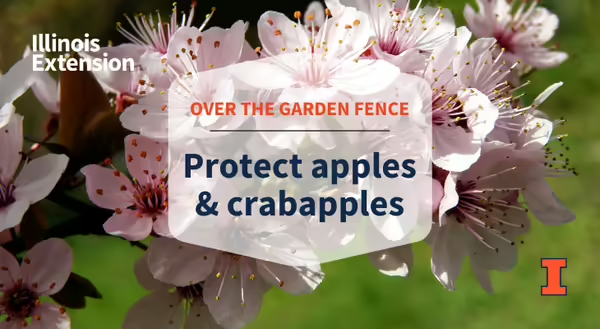
Our Master Gardener help desk gets emails mid-summer when apple trees drop many of their leaves, except for the outer 12 inches or so. The same thing can happen to our ornamental flowering crabapples. In both cases, the cause is the same – a fungal disease that infects the foliage and fruits. What is sad is by the time they see or report an issue, it is way too late to address the problem.
When does it happen?
That sneaky foliar fungal disease is out there right now, waiting for the right weather conditions and stage of development of our crabapples and apples. When it comes to apple scab, preventing the infection and spread is up to us, the gardeners. Spray treatments need to start when the apple and crab buds are just swelling, and we can see the very tiniest amount of green tissue showing. Protection is the name of game with this disease.
How long will I have to treat apple scab?
As long as the cool, moist to wet weather is with us, we need to keep up the preventative measures. The infection comes from overwintering spores in last year’s leaves still on the ground. Spraying the ground under your crab or apples is ineffective though, as the spores can come from anywhere in the neighborhood. Treatments can slow and then stop as warmer, drier air arrives, as the spores can no longer survive in those conditions. There, of course, is a “however” here. The cycle can continue on the tree once it is there, so you can see why preventing it to begin with is so important.
What is the process?
The goal is to protect newly emerging leaf tissue, so sprays are typically applied every 5 to 7 days, depending on the weather and product label. The weather influences that frequency, so you use the calendar and conditions to count between applications. For example, if you treat on a Saturday and then we have heavy rains immediately, effectiveness may be lost or at least limited, and another treatment is needed ASAP. Then you begin counting those days all over again. Those first sprays are directed at those emerging leaves and a bit later at flower buds too. The treatments are repeated until about 75 percent of the flower petals have fallen, this having protected very immature fruits up to that treatment. (Always read and follow produce label and safety instructions.)
Are there other protection sprays needed?
Sprays will need to continue on longer intervals to protect from other foliage and fruit diseases, if you want great looking apples or crabapple fruit, as well as the satisfaction of seeing your tree full of foliage for the whole growing year. These sprays are often called “cover sprays,” as you continue to keep the developing fruits covered and protected until just a few days before harvest (if it is an apple tree). The most convenient products are sold as “fruit tree spray or home orchard spray” in a liquid form, which is easier to handle than wettable powders. Keep in mind that at the beginning of season you may only need a gallon or less per tree. As the season progresses with mature foliage and maturing fruits, that could grow to 3 to 4 gallons per tree! As you think about what kind of sprayer you are going to use, keep in mind how often you want to have to refill. Find a sample spray schedule for apple trees from Extension Educator Kelly Allsup.
Interested in more on apple trees? Check out the 2021 fruit tree blog series.
Want to know when new topics post here? Subscribe to Over the Garden Fence emails.
About the author: Richard Hentschel’s expertise extends across several subject areas with specialties in lawn care, fruit tree production, woody ornamentals, and home and community gardening. During his 45-year career in horticulture and agriculture, Hentschel became a well-known and respected expert for commercial and homeowner audiences, industry organizations, and media. He retired from University of Illinois Extension in April 2022 with nearly 30 years of service as a Horticulture Specialist and Educator in northern Illinois.